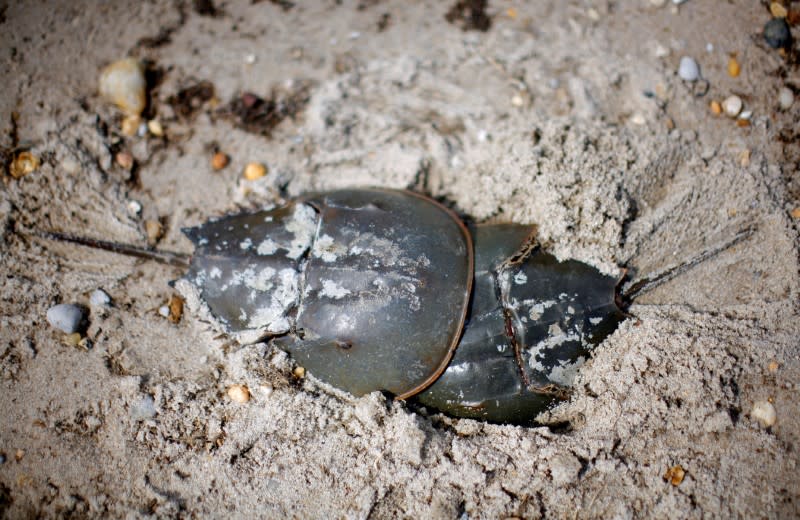Wildlife groups pressure Big Pharma to curb crab blood addiction
By John Miller
ZURICH (Reuters) - Wildlife advocates are pushing drugmakers to curb the use of horseshoe crab blood by switching to a synthetic alternative for safety tests, including those needed before a COVID-19 vaccine can be used on humans.
Fishermen net hundreds of thousands of the creatures off the U.S. East Coast and Asia every year, draining their prized milky-blue blood for use in medical safety tests that detect bacterial contamination in intravenous drugs or implants.
The National Audubon Society, Defenders of Wildlife and other groups called for greater use of a man-made option, called recombinant Factor C (rFC), in a statement released on Monday by umbrella organization the Horseshoe Crab Recovery Coalition.
They say this shift could save 100,000 horseshoe crabs annually on the U.S. East Coast alone and help threatened migratory birds that depend on crab eggs for survival.
"It is unfortunate that biomedical research still relies on the harvesting of a vulnerable wild animal population when there is a simple, effective, sustainable replacement," said Ryan Phelan, a campaigner with California-based conservation group Revive & Restore.
However, the testing industry's impact on the U.S. crab population is disputed, with varying estimates of how many die during bleeding or after they are returned to the ocean.
Swiss biotech company Lonza <LONN.S>, a leader in the field, said that good stewardship had led to "stable to increasing" populations.
Regulatory hurdles to rFC also remain, with U.S. standards group U.S. Pharmacopeia (USP) last week scrapping plans to put the synthetic test on an equal footing with industry-standard crab blood trials.
While Europe is moving to recognize the synthetic as comparable, USP announced on Friday that more data was needed to support such a move.
Adoption has lagged, in part, because drug regulators have demanded that rFC endotoxin tests undergo extra validations - adding time and cost - to prove they match the accuracy of crab blood.
So far, only two drugs, both from Eli Lily <LLY.N>, have been approved after relying on rFC for final endotoxin tests.
Eli Lilly, which has switched 90% of its safety testing to rFC since 2016, on Monday told Reuters that it supports the wildlife groups' aims to get more companies to follow suit.
The wildlife groups pledged to target U.S. legislators and regulators to spur action.
COPPER-RICH BLOOD
Horseshoe crabs' copper-rich blood has helped the species to survive for 450 million years - and made it a source of one of the drug industry's most unusual raw materials because it clots in the presence of bacterial endotoxins.
Drained from live crabs, the blood has long been the standard to detect contamination in shots, infusions and medical devices.
Companies including Lonza and Charles River Laboratories <CRL.N> are the biggest crab bleeders, supplying many of the 70 million annual endotoxin tests in a roughly $1 billion market.
More recently, man-made rFC from Lonza, France's bioMerieux <BIOX.PA> and others has emerged an alternative, and they have been pushing to gain market share, though Charles River has opposed recognition, sparking an industry battle.
Eli Lilly on Monday announced that it had begun testing a COVID-19 antibody in humans with all the safety testing done with rFC, said Jay Bolden, a Lilly biologist whose hobby as a birdwatcher spurred him to lead his company's switch to the synthetic.
There is sufficient scientific evidence, including from more than 40,000 samples tested by Lilly so far, to support the synthetic's comparability with crab blood, Bolden added.
"And that data is out there, and it's either not being looked at or it's being ignored," he told Reuters. "There's no reason the USP should be asking for more data."
(Reporting by John Miller; Editing by Pravin Char and David Goodman)


